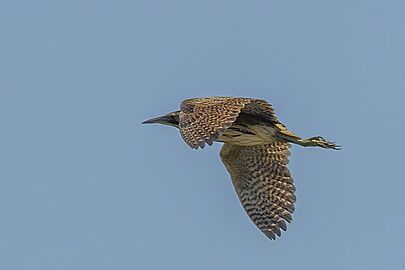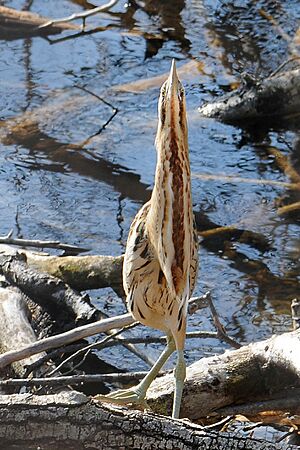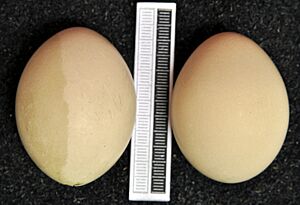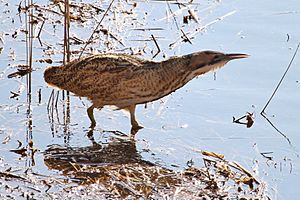Eurasian bittern facts for kids
Quick facts for kids Eurasian bittern |
|
|---|---|
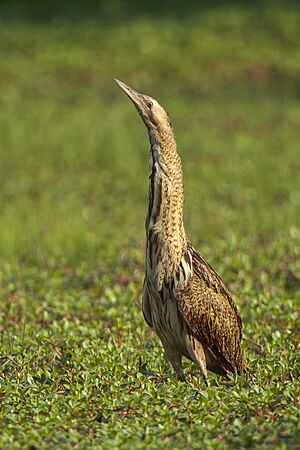 |
|
| Conservation status | |
| Scientific classification | |
| Genus: |
Botaurus
|
| Species: |
stellaris
|
| Subspecies | |
|
|
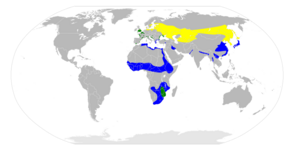 |
|
| Range of Botaurus stellaris: breeding year-round nonbreeding | |
| Synonyms | |
|
Ardea stellaris Linnaeus, 1758 |
|
The Eurasian bittern or great bittern (Botaurus stellaris) is a special type of wading bird. It belongs to the heron family, known for their long legs and necks. Bitterns are usually very shy and like to hide in tall reed beds near water. You might not often see them, but you can definitely hear them! In spring, the male bittern makes a very loud, deep "booming" sound that can travel for miles.
There are two main types, or subspecies, of the Eurasian bittern. One lives in parts of Europe and Asia, and also along the northern coast of Africa. The other type lives only in southern Africa. These birds eat fish, small mammals, young birds, frogs, crabs, and insects.
Bitterns usually build their nests among reeds right at the edge of the water. The female bird takes care of the eggs and feeds the young chicks. The chicks leave the nest when they are about two weeks old, but their mom continues to look after them until they can fly on their own, usually around six weeks later.
Sadly, the places where bitterns live, like wetlands, are shrinking. This means their numbers are slowly going down around the world. However, their decline is not fast enough for them to be considered highly endangered. So, the International Union for Conservation of Nature says they are of "least concern". Still, some local groups of bitterns are in trouble, especially the ones in southern Africa, whose numbers have dropped a lot. In the United Kingdom, the Eurasian bittern is one of the most threatened bird species.
Contents
What is a Eurasian Bittern?
Bitterns are chunky birds that look a bit like herons. They have light, buffy-brown feathers with dark stripes and spots. This helps them blend in with the reeds. The Eurasian bittern is the largest of all the bitterns. Males are usually bigger than females. These birds are about 69 to 81 centimeters (27 to 32 inches) long. Their wings can spread out to 100 to 130 centimeters (39 to 51 inches) wide. They weigh between 0.87 and 1.94 kilograms (1.9 to 4.3 pounds).
Their head and neck are black with buff (pale yellowish-brown) tips on the feathers. They have a yellowish stripe above their eyes and a brownish-black stripe near their beak. Their chest and belly are yellowish-buff with brown stripes. Their tail is rusty-buff with black streaks. Their wings are pale rusty-brown with black markings. The feathers on their head, neck, and chest can stand up, which helps them hide. Their strong beak is greenish-yellow, and their eyes are yellow. Their legs and feet are greenish. Young bitterns look similar to adults but are a bit paler.
Where do Eurasian Bitterns Live?
The Eurasian bittern lives in many parts of Europe and Asia. You can find them from the British Isles all the way east to Japan. They also live in small numbers in Morocco, Algeria, and Tunisia in North Africa. They love to live in reed beds and swamps, as well as near lakes and slow-moving rivers that have lots of plants around them. They prefer large reed beds that are at least 20 hectares (50 acres) big for breeding.
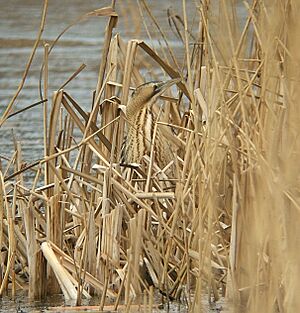
Some bitterns stay in the same place all year. But many of the ones living in colder northern areas fly to warmer places for winter. For example, birds from northern Europe often move to southern Europe, North Africa, or central Africa. Asian birds might fly to the Arabian Peninsula or India. When they are not breeding, they can live in other wet places like rice fields, fish farms, and flooded areas.
The other type of Eurasian bittern, called B. s. capensis, lives only in southern Africa. They are found in marshes near the east coast, the Okavango Delta, and the mountains. These birds usually stay in their home areas all year.
How do Bitterns Behave?
Eurasian bitterns are usually alone. They hunt for food in reed beds, walking very slowly and carefully, or standing still above the water. They are very shy. If they feel threatened, they often point their beak straight up and freeze. This makes their striped feathers blend in perfectly with the reeds, making them almost impossible to see! This special hiding trick is called bitterning.
Sometimes, especially in cold winter weather, you might see a bittern standing out in the open near the water. But they always stay close to cover so they can quickly hide if needed. When they fly, their wings look wide and round, and their legs trail behind them, just like other herons. They don't fly very often, preferring to move quietly through the plants on foot. They walk slowly and carefully and can even climb over reeds by grabbing them with their toes. They are most active around sunrise and sunset, but sometimes they hunt during the day too.
What do Bitterns Eat?
Eurasian bitterns eat fish, small mammals, amphibians (like frogs), and insects. They hunt in shallow water along the edges of reed beds. In the UK, they have been seen eating eels up to 35 centimeters (14 inches) long, other fish, mice, voles, small birds, frogs, newts, crabs, shrimps, snails, spiders, and many kinds of insects. They also sometimes eat water plants.
Reproduction and Life Cycle
Male bitterns can mate with several females. The nest is built by the female using old reeds, sedges, and grass stalks. It's a messy platform about 30 centimeters (12 inches) wide, often on a clump of grass surrounded by water.
The female lays four to six eggs in late March or April. The eggs are olive-brown and about 50 by 40 millimeters (2 by 1.6 inches) in size. The female sits on the eggs for about 26 days until they hatch. After hatching, the chicks stay in the nest for about two weeks before they start swimming among the reeds. The female raises the chicks by herself. She brings food back to the nest in her throat, and the young birds grab her beak to get the food. They are ready to fly on their own when they are about eight weeks old.
The Bittern's Booming Voice
The male bittern's mating call is a very deep, loud sound that sounds like a fog-horn or a bull's bellow. It's called a "boom" and can be heard from about 3 miles (5 kilometers) away on a quiet night! They mainly make this call between January and April during the mating season. Scientists often count the number of booming males in an area to keep track of the bittern population.
For a long time, people didn't know how such a small bird could make such a deep sound. Some thought it blew into a straw or into the water. But now we know that the bittern makes the sound by pushing air out of its throat using strong muscles around it.
Conservation Status: Are Bitterns Safe?
The Eurasian bittern lives across a very large area and has a big total population, estimated to be between 110,000 and 340,000 birds. The International Union for Conservation of Nature has decided that its overall conservation status is "least concern". This means that even though their numbers are going down, they are not declining fast enough to be considered highly threatened.
The biggest danger to bitterns is the loss of their homes, like reed beds and wetlands, due to draining and human activity. The Eurasian bittern is one of the birds protected by the Agreement on the Conservation of African-Eurasian Migratory Waterbirds (AEWA). The southern type of bittern has faced a huge drop in numbers over the last century because their wetland homes have been damaged. Unlike the northern type, this southern population is a big worry for conservationists.
In the United Kingdom, the Eurasian bittern completely disappeared in the late 1800s. They didn't successfully breed there again until 1911. Their numbers slowly grew to about 70 pairs in the 1950s, but then dropped to fewer than 20 pairs in the late 1990s. Thanks to conservation efforts, the number of breeding males in the UK increased to 228 in 2021! Bitterns have also started breeding in new areas, like north Wales and south Wales, where they hadn't been seen breeding for about 250 years. In the 21st century, bitterns are regular winter visitors to the London Wetland Centre, allowing people in the city to see these special birds. In Ireland, they stopped breeding in the mid-1800s, but a few have been spotted since 2011.
Bitterns in Stories and Poems
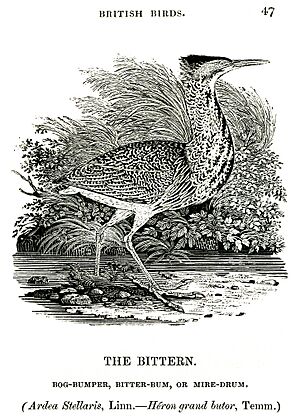
The Eurasian bittern's loud "boom" has appeared in many old stories and poems. People used to think the bird made its sound by sticking its beak into the muddy ground or water. This idea even shows up in Chaucer's The Wife of Bath's Tale from 1476:
And, as a bitore bombleth in the myre,
She leyde hir mouth un-to the water doun
In the famous Sherlock Holmes novel The Hound of the Baskervilles, the character Stapleton suggests that the mysterious howl people hear is actually the sound of a bittern.
Camouflage Secrets
The bittern's amazing ability to blend in with its surroundings has also been studied. The zoologist Hugh Cott described how difficult it was to find a bittern that had landed in a marsh. It was "clinging motionless, with bill almost erect, to a stem of wild oats," making it almost invisible!
Images for kids





